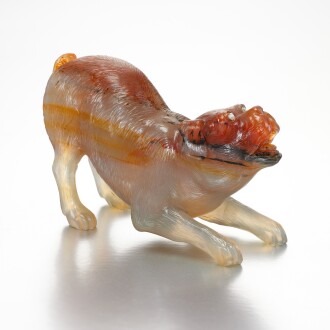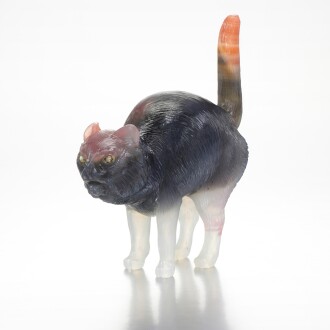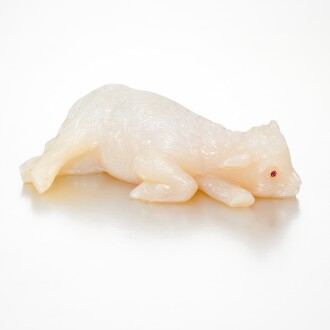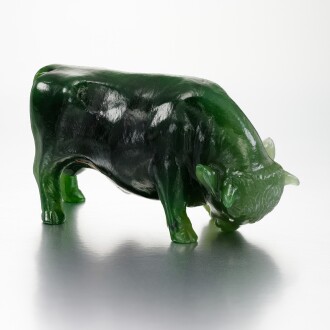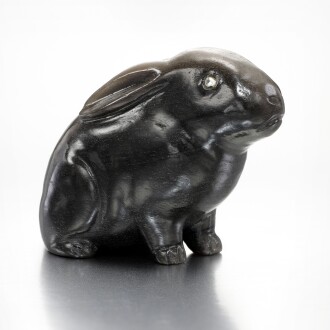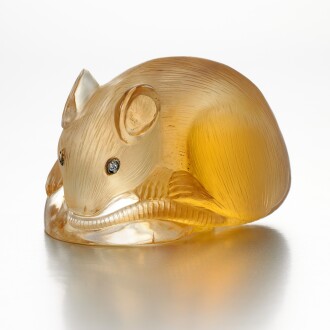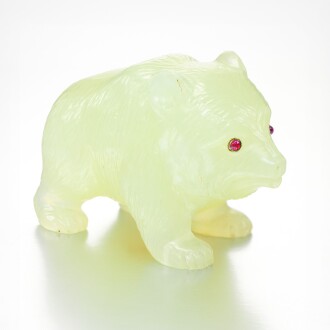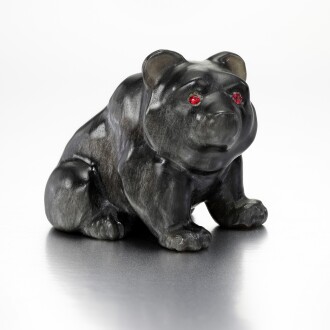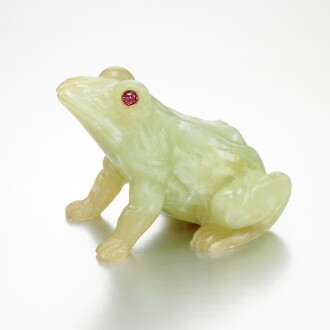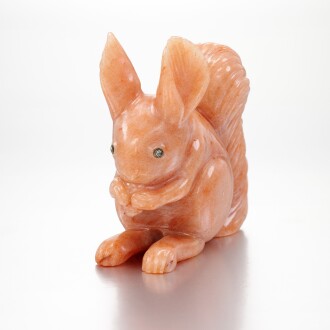L eading our series of sales as part of Russian Art in London 2020 is a distinguished collection of Fabergé from the Brooklyn Museum of Art, sold to support museum collections. The collection was assembled in the 1950s and boasts rich exhibition history and quality. Highlights include the Imperial ‘Balletta’ Vase, a rare and important Fabergé two-colour gold and smoky topaz vase given Grand Duke Alexei Alexandrovich (1850-1908) to Elizabeta Balletta, prima ballerina at the Imperial Mikhailovsky Theatre, Fabergé animals, flowers and a stunning Fabergé hardstone clock. Representing the best of Fabergé’s famous lapidary work, Sotheby’s is honoured to bring this collection to the market for the first time since it was acquired.
The Intricate Carvings and Iconic Designs of Fabergé

"Balletta...and her Fabergé smoky rock crystal goblet of surpassing beauty… perhaps the most beautiful thing Fabergé ever made."
The present collection epitomises the way in which the famous firm of Fabergé captured the imagination and patronage of the Imperial family, Royals and High Society from St Petersburg and Moscow to London. As the Imperial Easter Eggs demonstrate, Fabergé was the chosen jeweller for the most important gifts commission and given by the Imperial Family. The Imperial ‘Balletta’ vase in this collection, represents one such important gift, given by Grand Duke Alexei Alexandrovich (1850-1908) to Elizabeta Balletta, prima ballerina at the Imperial Mikhailovsky Theatre and is rarer than the Imperial Easter Eggs in that it is the only such vase known to have been made by the firm.

Grand Duke Alexei and Elizabeth Balletta
Elizabeth Balletta became one of the most famous dancers of the Imperial Mikhailovsky Theatre in Saint Petersburg, and was first noticed by Tsarevich Nikolai Alexandrovitch, before having a long relationship with his uncle, Grand Duke Alexei Alexandrovitch. Balletta was twenty-four years old, when she first met Grand Duke Alexei, who was fifty at the time. She was soon nicknamed by the press ‘Diamond Majesty’ because she would appear on the stage of the Mikhailovsky Theater, studded with diamonds, entwined with emeralds and bedecked in rubies, all given to her by the Grand Duke. She quickly became a prima ballerina, and it was widely suggested that her relationship with Grand Duke Alexei played a role in her ascent.

Grand Duke Alexei was Admiral General of the Imperial Army of Russia and travelled widely, including a tour of the United States, Japan and England; but was known more for his life of ‘fast women and slow ships’ rather than his military accomplishments. In 1903, a scandal broke out: thirty million roubles, half of the budget of the Russian navy, disappeared even though not a single new ship was launched. Meanwhile, Grand Duke Alexei bought a magnificent mansion in Paris. A year later, under the command of Grad Duke Alexei, the Russian navy lost the Battle of Tsushima to the Japanese in 1905. Following the defeat, Elizabeth Balletta appeared on the stage bedecked in diamonds and the audience cried: ‘She has our fleet in her ears! On her every finger there is a cruiser!’. Following the defeat, the Grand Duke resigned and left for his Parisian mansion, where he died of a cold on November 1, 1908. His body was solemnly transported to St Petersburg and buried with all kinds of honours. Balletta was allowed to come to the funeral, but never returned to Russian Society.
"…dying in the apartment of a Parisian actress. No one was present at the time of death but a French music hall singer known in Russia by the name of La Ballet[t]a … Alexis found nothing better to do than to come to Paris and display as publicly as possible his affection for La Balletta. La Balletta, who has been amply provided for out of imperial funds, was allowed to accompany the funeral cortege in a closed carriage."
Known for his generosity, Grand Duke Alexei lavished gifts upon Elizabeth Balletta and her collection was renowned in its own time. The surpassing quality of her Fabergé and jewels has historically incited great competition in collectors, who seek her provenance. Famously a Fabergé guilloché enamel case from her collection, decorated with intertwined monograms 'EB' and 'A', was first sold to the distinguished collector Lansdell K. Christie, who then auctioned it between 1973-1974 for the record sum of 190,000 Swiss francs.
This large and impressive smoky quartz vase is completely unique in Fabergé’s production and represents the apogee of the firm’s lapidary works. Perfectly carved from a huge piece of smoky quartz and mounted in the highest carat gold, it represents a costly and lavish imperial gift from Grand Duke Alexei Alexandrovich of Russia (1850-1908) to his favourite actress, Elizabeth Balletta. Grand Duke Alexei presented many gifts to Elizabeth Balletta, but the present vase in both its scale and exceptional craftsmanship is undoubtedly the most opulent.

In addition to the fantastic example of Fabergé’s Imperial patronage seen in the ‘Balletta’ vase, the lapis and nephrite clock from this collection gives us insight both into the allure of Fabergé to high society collectors and to the design process of its workshops.
Mrs Leeds, Princess Anastasia of Greece and Denmark
"The Society sensation of the present season here has certainly been Mrs. William B. Leeds, with her marvellous gowns and jewels. The latter embellishment of the youthful widow’s beauty has caused the greatest astonishment in Paris…since this memorable ball, Paris has been talking of nothing else but Mrs Leeds"
This clock was originally purchased in 1915 by Mrs Leeds, one of Fabergé’s most extravagant and prolific customers in London. First introduced to the delights of Fabergé by Lady Paget, Nancy Leeds, made her first purchase from the firm in 1913, for the handsome sum of £208.10s. Her purchases from the London Branch of Fabergé between 1913 and 1917 amounted to £3,292 and were primarily made between 1915 and 1916 while she lived at 41 Grosvenor Square. She was a great patron of Cartier, as well where she purchased lavish jewels, but preferred Fabergé for objets de vertu, including clocks such as the present lot, cigarette cases, animal carvings, flower studies and frames. Her collection even included a Fabergé mistletoe sprig similar to that in the present sale (K. McCarthy, Fabergé in London, China, pp. 167-168).
Eventually known as Princess Anastasia of Greece and Denmark (1878 – 1923), Nancy Leeds was a wealthy American heiress. Her second husband William Bateman Leeds (1861 – 1908) had amassed a vast fortune in the tin industry and when he died in 1908 left her an inheritance of nearly forty million dollars.
The wealthy, thirty-year-old widow chose to settle in Europe, where she socialised among the aristocracy and became a member of the Greek and Danish Royal Families through her third marriage to Prince Christopher of Greece and Denmark (1888 – 1940), the youngest child of King George I of Greece (1845 – 1913) and his consort, Grand Duchess Olga Constantinovna of Russia (1851 – 1926). Her fortune notably helped fund the Greek Royal Family during their exile in the 1920s.
As a fervent jewels lover and collector, Leeds was a noted client of Cartier, having her own hall in the famous French jewelry shop. Her jewelry collection was estimated to be worth over a million dollars, including many stones, believed to be unique for size and perfection of quality. In 1910, she created a stir by buying a Cartier necklace of pearls and diamond rondelles for $570,000. In the portrait of her by Giovanni Boldini, executed in 1914, the princess is wearing a tiara surmounted by seven diamonds created by Cartier a year before.

The Original Design Source Discovered
Remarkably this Fabergé clock also gives us direct insight into the design process of Fabergé’s head workmaster, Henrik Wigström. The first stage of its design, was a sketch by the headworkmaster or even Carl Fabergé himself, which was then executed by specialist lapidaries, stone setters and goldsmiths. Many of these designs have been lost, but the forthcoming publication of Henrik Wigström's second album of drawings by Ulla Tillander-Godenhielm et al. includes the original design for this clock, recorded under number 15165. The design suggests that two versions of the clock were created, and illustrates the present clock to the left, detailing the setting of demantoid garnet gems in the nephrite wreath. The discovery of this design, is an exciting and important addition to the storied history of this exceptional Fabergé clock.


- Nephrite

Sourced and chosen from massive boulders near Lake Baikal in Siberia and the Sayan Highlands in the Altai Mountains.
- Diamond
- Agate
- Diamond
- Agate
- Diamond
- Chalcedony
- Ruby

Ruby source from the Southern Ural Mountains, discovered in 1825 when alluvial gold was found containing corundium in the Kamenlza and Sanarlza River basins.
- Obsidian
- Diamond

The Brooklyn Museum of Art’s Fabergé collection was formed as the bequest of Helen Babbott Sanders in 1983. Highlighted by the Imperial smoky quartz ‘Balletta’ vase (lot 12), this group of Fabergé and vertu was assembled by Helen Babbott Sanders in the 1950s. Helen Babbott Sanders was the daughter of Frank L. Babbott, who was President of the Board of the Brooklyn Museum from 1920 to 1928 and one of its chief benefactors. She was a member of the museum’s acquisition committee and collected with an emphasis on excellence, as is reflected in this Fabergé collection and her bequest of Renaissance paintings.

The works in this sale are one of the only remaining groups that were built in a Golden Age of Fabergé collecting in America. Sanders acquired these pieces alongside the other great Fabergé enthusiasts of her era, such as Frank Sinatra, Bing Crosby and Lansdell K. Christie, whose works formed the basis of the Forbes Collection. The iconic, glamorous and thoughtful way in which this collection was acquired, mainly at A La Vieille Russie on 5th Avenue, makes it a rare and exceptional appearance on the market.

With the advent of World War II, Russian art could no longer be sourced from the Soviet Union, but rather from secondary sources, such as Russian émigrés and collections formed in the 30s and 40s. As a result, collectors in the 1950s mainly acquired items from A La Vieille Russie in New York, Wartski in London and through major auction houses. Helen Babbott Sanders, like many great Fabergé enthusiasts of her time, purchased much of her collection from A La Vieille Russie, whose many famous clients include the goldsmith Carl Fabergé himself. A family enterprise since its founding in Kiev in 1851, A La Vieille Russie re-established itself in Paris around 1920 following the Russian Revolution. The firm was run in Paris by Jacques Zolotnitsky, the grandson of the founder and in 1941 its New York branch was established by the late Alexander Schaffer. The New York branch continues under the direction of Messrs. Paul and Peter L. Schaffer and Dr. Mark Schaffer.
It is the New York branch on 5th Avenue that attracted Helen Babbott Sanders’s attention in the 1950s, leading her to acquire the majority of her collection there. The delight that she took in visiting A La Vieille Russie is evident in the whimsy of the Fabergé animals and flowers she acquired there and the importance of the Imperial ‘Balletta’ vase.

Following Helen Babbott Sander’s death, the present collection moved to the Brooklyn Museum of art in 1983. Throughout its history works from the collection have been exhibited internationally. The Imperial ‘Balletta’ vase impressively has exhibition history tracing back to 1935 when it was included in the famous Exhibition of Russian Art held in Belgrave Square, London listed as ‘lent by Madame Balletta, Paris’. And was included in the manager of Fabergé in London, Henry Bainbridge’s 1949 publication on the life and works of Peter Carl Fabergé as:
"Balletta...and her Fabergé smoky rock crystal goblet of surpassing beauty… perhaps the most beautiful thing Fabergé ever made."
The vase, as with so many of the superbly executed works in this collection, was famous in its own time.


The works in the Brooklyn museum’s collection give great insight into the way that Fabergé greatly influenced the design and range of works created by Cartier in the early 20th century.

clock, Cartier, early 20th century, sold Sotheby's Geneva, 13 September 2019, Lot 20
Right: A Rare and important Faberge Jewelled, Gold-mounted, Lapis Lazuli, Nephrite and Guilloche Enamel Clock, Workmaster Henrick Wigstrom, St Petersburg, Circa 1990, Lot 11
It is no surprise that the blue and green Fabergé clock in this collection (lot 11) was purchased in 1915 by Mrs Leeds, a wealthy American heiress was a prolific collector of both Fabergé and Cartier. The two firms were in direct dialogue and great competition for Imperial, Royal and wealthy patronage and Mrs Leed’s Fabergé clock is a notable example of the way in which Fabergé inspired Cartier objects.

Right: A Rare Faberge Jewelled Agate Model of a Dog, St Petersburg, Circa 1900, Lot 1 Jasper "Yogi" Gough
The presence of Fabergé at the 1900 Universal Exhibition in Paris sparked interest and admiration in the Cartier brothers, causing them to reinterpret a number of Fabergé’s signature designs, notably desk clocks, animals and flower studies. Cartier’s interest in emulating works by Fabergé was driven both by aesthetics and the allure of Russian patronage. At the turn of the twentieth century, the south of France was a fashionable destination for wealthy Russian and the country also experienced an influx of Russian émigrés following the assassination of Emperor Alexander II in 1881, making Russians very important clientele for Cartier.

Right: A Faberge Jewelled Obsidian Model of a Rabbit, St Petersburg, Circa 1990, Lot 5
Fabergé was of such great interest to Cartier that Pierre Cartier made several trips to Russia in 1904 and 1905 to buy enamel and hardstone carvings and generate relationships with local workshops such as the Yahrworkshop, which also possessed the secret enamelling technologies and methods that made Fabergé so famous. Through the use of these regional workshops, Pierre Cartier endeavoured to compete with Fabergé. As a result, Cartier created Russian jewellery in deeper colour hues and experimented with guilloché enamelling, calling it ‘Russian Rays’. Eventually Cartier’s interpretations of Faberge designs won the the warrant ‘Royal Jeweler to the Imperial Russian Court.’ He was unable to open an official Russian branch, however, because Fabergé’s dominance of regional social and political influence proved to be too strong for Cartier to maintain a real presence in St Petersburg.

Right: A Jewelled Adventure Model of a Squirrel, Cartier, Paris, Early 20th Century, Lot 15
While directly inspired by Fabergé designs, Cartier's Russian objects never matched the craftsmanship, ingenuity or quality of materials used in Fabergé's original designs. The works in the collection of the Brooklyn museum of art illustrate the superior craftsmanship of Fabergé: the character filled and expertly sculpted animal figures, flower studies of the highest quality and the Fabergé desk clock, which is a triumph of the firm's lapidary workshops.





